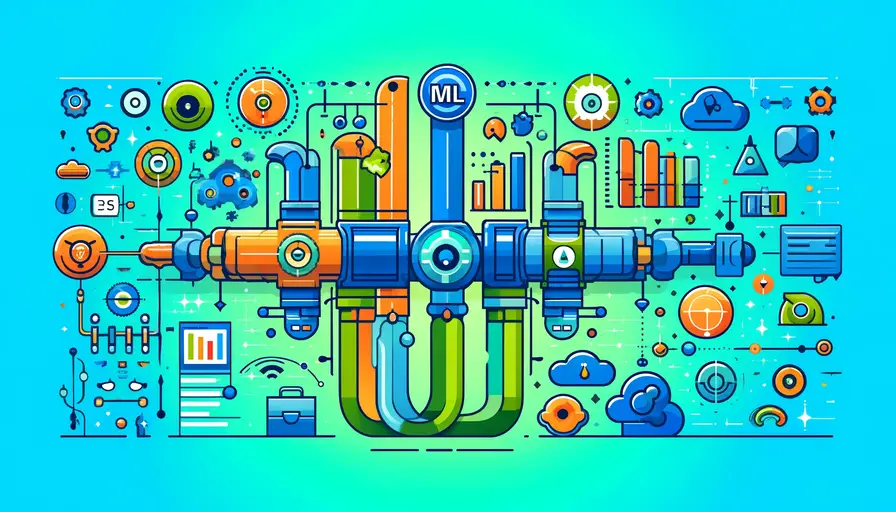
Data Pipeline vs Machine Learning Pipeline

- Understanding Data Pipelines
- Benefits of Data Pipelines
- Understanding Machine Learning Pipelines
- Benefits of Machine Learning Pipelines
- Differences Between Data Pipelines and Machine Learning Pipelines
- Choosing the Right Pipeline for Your Needs
- Integrating Data Pipelines with Machine Learning Pipelines
Understanding Data Pipelines
Data pipelines are essential components in data processing, ensuring the smooth flow of data from source to destination. They enable the collection, transformation, and loading of data across various systems and applications, facilitating efficient data management.
What Are Data Pipelines?
A data pipeline automates the movement and transformation of data between different sources and destinations. It encompasses processes such as data ingestion, cleaning, transformation, and loading into storage systems like data warehouses or data lakes. Data pipelines ensure that data is available in the right format and at the right time for analysis and decision-making.
Key Components of Data Pipelines
Data pipelines typically include components such as data sources, data extraction, data transformation, and data loading. These components work together to collect raw data, process it, and store it in a structured format. Common tools used for building data pipelines include Apache Kafka, Apache Airflow, and AWS Glue.
Example: Building a Data Pipeline with Apache Airflow
Here's an example of building a simple data pipeline using Apache Airflow:
Clustering in Data Analysis: Key Considerations and Best Practicesfrom airflow import DAG
from airflow.operators.python_operator import PythonOperator
from datetime import datetime
def extract():
# Extract data from source
return "data"
def transform(data):
# Transform data
return data.upper()
def load(data):
# Load data to destination
print(f"Loading data: {data}")
default_args = {
'owner': 'airflow',
'start_date': datetime(2021, 1, 1),
}
dag = DAG('data_pipeline', default_args=default_args, schedule_interval='@daily')
extract_task = PythonOperator(task_id='extract', python_callable=extract, dag=dag)
transform_task = PythonOperator(task_id='transform', python_callable=transform, op_args=[extract_task.output], dag=dag)
load_task = PythonOperator(task_id='load', python_callable=load, op_args=[transform_task.output], dag=dag)
extract_task >> transform_task >> load_taskBenefits of Data Pipelines
Data pipelines offer numerous benefits, including automation, scalability, and reliability. They streamline data workflows, reduce manual intervention, and ensure consistent data quality.
Automation
Data pipelines automate repetitive tasks, such as data extraction, transformation, and loading. This automation reduces the risk of human error and frees up resources for more strategic tasks. Automated pipelines can handle large volumes of data, ensuring timely and accurate data processing.
Scalability
Data pipelines are designed to scale with growing data volumes and complexity. They can accommodate increasing data sources and processing requirements, ensuring that data workflows remain efficient and responsive. Tools like Apache Kafka and Google Cloud Dataflow are known for their scalability.
Reliability
Data pipelines ensure data consistency and reliability by handling errors and failures gracefully. They include mechanisms for error detection, retries, and logging, ensuring that data flows smoothly even in the face of disruptions. This reliability is crucial for maintaining data integrity and trust.
Mastering the Zero-Inflated Model: A Machine Learning Must-HaveUnderstanding Machine Learning Pipelines
Machine learning pipelines automate the end-to-end process of developing, training, and deploying machine learning models. They streamline workflows, enhance reproducibility, and ensure that models are consistently trained and evaluated.
What Are Machine Learning Pipelines?
A machine learning pipeline is a series of steps that automate the machine learning workflow, from data preprocessing to model deployment. It includes tasks such as data cleaning, feature engineering, model training, hyperparameter tuning, and model evaluation. Machine learning pipelines enable the efficient and scalable development of machine learning models.
Key Components of Machine Learning Pipelines
Machine learning pipelines typically include components such as data preprocessing, feature engineering, model training, model evaluation, and model deployment. These components work together to ensure that models are built, trained, and deployed systematically. Common tools for building machine learning pipelines include TensorFlow Extended (TFX), Kubeflow, and MLflow.
Example: Building a Machine Learning Pipeline with Scikit-Learn
Here's an example of building a simple machine learning pipeline using Scikit-Learn:
Extracting a Machine Learning Model: A Step-by-Step Guidefrom sklearn.pipeline import Pipeline
from sklearn.preprocessing import StandardScaler
from sklearn.linear_model import LogisticRegression
from sklearn.datasets import load_iris
from sklearn.model_selection import train_test_split
# Load dataset
data = load_iris()
X_train, X_test, y_train, y_test = train_test_split(data.data, data.target, test_size=0.2, random_state=42)
# Define pipeline
pipeline = Pipeline([
('scaler', StandardScaler()),
('classifier', LogisticRegression())
])
# Train model
pipeline.fit(X_train, y_train)
# Evaluate model
score = pipeline.score(X_test, y_test)
print(f"Model Accuracy: {score}")Benefits of Machine Learning Pipelines
Machine learning pipelines offer several benefits, including reproducibility, scalability, and efficiency. They standardize machine learning workflows, making it easier to build, train, and deploy models.
Reproducibility
Machine learning pipelines ensure that workflows are reproducible, enabling consistent results across different runs. By automating each step, pipelines reduce the risk of variability and make it easier to replicate experiments and results. This reproducibility is crucial for model validation and deployment.
Scalability
Machine learning pipelines are designed to handle large datasets and complex models. They can scale horizontally and vertically, accommodating increasing data volumes and computational requirements. Tools like Kubeflow and TensorFlow Extended (TFX) are known for their scalability and support for distributed training.
Efficiency
Machine learning pipelines streamline workflows, reducing the time and effort required to build and deploy models. They automate repetitive tasks, such as data preprocessing and hyperparameter tuning, allowing data scientists to focus on more strategic aspects of model development. This efficiency leads to faster model iteration and deployment.
Scikit-Learn: A Python Machine Learning LibraryDifferences Between Data Pipelines and Machine Learning Pipelines
While both data pipelines and machine learning pipelines automate workflows, they serve different purposes and have distinct characteristics. Understanding these differences can help you choose the right approach for your needs.
Purpose and Focus
Data pipelines focus on the movement, transformation, and storage of data. They ensure that data is available, clean, and ready for analysis. In contrast, machine learning pipelines focus on the end-to-end process of building, training, and deploying machine learning models. They encompass tasks such as data preprocessing, feature engineering, model training, and evaluation.
Components and Steps
Data pipelines include components like data sources, extraction, transformation, and loading. They automate the flow of data between systems, ensuring data quality and consistency. Machine learning pipelines, on the other hand, include components like data preprocessing, feature engineering, model training, hyperparameter tuning, and deployment. They automate the machine learning workflow, ensuring reproducibility and efficiency.
Tools and Technologies
Data pipelines use tools like Apache Kafka, Apache Airflow, and AWS Glue for data movement and transformation. Machine learning pipelines use tools like TensorFlow Extended (TFX), Kubeflow, and MLflow for model development and deployment.
Support Vector Machines for Machine LearningChoosing the Right Pipeline for Your Needs
Selecting the right pipeline depends on your specific use case, data requirements, and goals. Consider the purpose, components, and tools of each pipeline to determine the best fit for your needs.
Assess Your Use Case
Identify the primary objective of your pipeline. If your goal is to move and transform data across systems, a data pipeline is the right choice. If your goal is to build, train, and deploy machine learning models, a machine learning pipeline is more suitable.
Evaluate Your Data Requirements
Consider the volume, variety, and velocity of your data. Data pipelines are designed to handle large volumes of data and complex transformations. Machine learning pipelines, on the other hand, are designed to preprocess data, engineer features, and train models. Evaluate your data requirements to choose the right pipeline.
Determine Your Goals
Consider your long-term goals and scalability requirements. Data pipelines ensure efficient data movement and transformation, supporting data analysis and decision-making. Machine learning pipelines ensure efficient model development and deployment, supporting predictive analytics and automation.
What is Long Short-Term Memory?Integrating Data Pipelines with Machine Learning Pipelines
Integrating data pipelines with machine learning pipelines can enhance the efficiency and effectiveness of your workflows. This integration ensures that data flows seamlessly from source to model, enabling real-time analytics and decision-making.
Data Ingestion and Preprocessing
Integrate data pipelines to handle data ingestion and preprocessing tasks. Use data pipelines to collect, clean, and transform data before feeding it into machine learning pipelines for training and evaluation. This integration ensures that your models are trained on high-quality data.
Real-Time Data Processing
Combine data pipelines with machine learning pipelines for real-time data processing. Use data pipelines to ingest and process real-time data streams, and machine learning pipelines to perform real-time inference and decision-making. This integration supports applications like fraud detection, predictive maintenance, and recommendation systems.
Example: Integrating Data and Machine Learning Pipelines
Here's an example of integrating data pipelines with machine learning pipelines using Apache Airflow and Scikit-Learn:
from airflow import DAG
from airflow.operators.python_operator import PythonOperator
from datetime import datetime
from sklearn.pipeline import Pipeline
from sklearn.preprocessing import StandardScaler
from sklearn.linear_model import LogisticRegression
from sklearn.datasets import load_iris
from sklearn.model_selection import train_test_split
def extract():
# Extract data from source
data = load_iris()
X_train, X_test, y_train, y_test = train_test_split(data.data, data.target, test_size=0.2, random_state=42)
return X_train, X_test, y_train, y_test
def transform(X_train, X_test):
# Transform data
scaler = StandardScaler()
X_train_scaled = scaler.fit_transform(X_train)
X_test_scaled = scaler.transform(X_test)
return X_train_scaled, X_test_scaled
def train(X_train, y_train):
# Train model
model = LogisticRegression()
model.fit(X_train, y_train)
return model
def evaluate(model, X_test, y_test):
# Evaluate model
score = model.score(X_test, y_test)
print(f"Model Accuracy: {score}")
default_args = {
'owner': 'airflow',
'start_date': datetime(2021, 1, 1),
}
dag = DAG('data_ml_pipeline', default_args=default_args, schedule_interval='@daily')
extract_task = PythonOperator(task_id='extract', python_callable=extract, dag=dag)
transform_task = PythonOperator(task_id='transform', python_callable=transform, op_args=[extract_task.output], dag=dag)
train_task = PythonOperator(task_id='train', python_callable=train, op_args=[transform_task.output], dag=dag)
evaluate_task = PythonOperator(task_id='evaluate', python_callable=evaluate, op_args=[train_task.output], dag=dag)
extract_task >> transform_task >> train_task >> evaluate_taskUnderstanding the differences and similarities between data pipelines and machine learning pipelines is crucial for selecting the right approach for your needs. Data pipelines focus on the movement, transformation, and storage of data, while machine learning pipelines focus on the development, training, and deployment of machine learning models. By assessing your use case, data requirements, and goals, you can choose the right pipeline to support your data and machine learning workflows. Integrating data pipelines with machine learning pipelines can further enhance efficiency, enabling seamless data flow and real-time decision-making. Whether you are managing large volumes of data or developing sophisticated machine learning models, selecting the right pipeline is essential for achieving your objectives.
If you want to read more articles similar to Data Pipeline vs Machine Learning Pipeline, you can visit the Algorithms category.



You Must Read